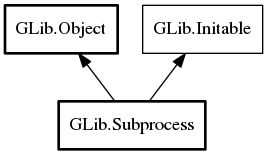Subprocess
Object Hierarchy:

Description:
Subprocess allows the creation of and interaction with child processes.
Processes can be communicated with using standard GIO-style APIs (ie: InputStream , OutputStream). There are GIO-style APIs to wait for process termination (ie: cancellable and with an asynchronous variant).
There is an API to force a process to terminate, as well as a race-free API for sending UNIX signals to a subprocess.
One major advantage that GIO brings over the core GLib library is comprehensive API for asynchronous I/O, such splice_async. This makes GSubprocess significantly more powerful and flexible than equivalent APIs in some other languages such as the `subprocess.py` included with Python. For example, using Subprocess one could create two child processes, reading standard output from the first, processing it, and writing to the input stream of the second, all without blocking the main loop.
A powerful communicate API is provided similar to the `communicate()` method of `subprocess.py`. This enables very easy interaction with a subprocess that has been opened with pipes.
Subprocess defaults to tight control over the file descriptors open in the child process, avoiding dangling-fd
issues that are caused by a simple fork/exec(). The only open file descriptors in the spawned process are ones that were
explicitly specified by the Subprocess API (unless
g_subprocess_flags_inherit_fds was specified).
Subprocess will quickly reap all child processes as they exit, avoiding "zombie processes" remaining around for long periods of time. wait can be used to wait for this to happen, but it will happen even without the call being explicitly made.
As a matter of principle, Subprocess has no API that accepts shell-style space-separated strings. It will, however, match the typical shell behaviour of searching the PATH for executables that do not contain a directory separator in their name.
Subprocess attempts to have a very simple API for most uses (ie: spawning a subprocess with arguments and support for most typical kinds of input and output redirection). See Subprocess. The SubprocessLauncher API is provided for more complicated cases (advanced types of redirection, environment variable manipulation, change of working directory, child setup functions, etc).
A typical use of Subprocess will involve calling Subprocess, followed by wait_async or wait. After the process exits, the status can be checked using functions such as get_if_exited (which are similar to the familiar WIFEXITED-style POSIX macros).
Namespace: GLib
Package: gio-2.0
Content:
Properties:
Creation methods:
Methods:
Inherited Members:
All known members inherited from class GLib.Object

All known members inherited from interface GLib.Initable
